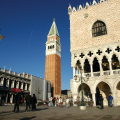Heart of the political and administrative life of the Republic, the Doge's Palace keeps the memory of the history of Venice.
The Ducal Palace, or Doge's Palace, was not only the residence of the Doges but also the seat of government and justice of the Republic for over 10 centuries. Today it remains one of the strongest symbols of the city of Venice and its prestigious past. It is also visually the most emblematic example of Venetian-Gothic architecture.
Initially (9th century) the residence of the doges, the palace was redesigned and definitively rebuilt in Venetian-Byzantine style under Doge Sebastiano Ziani (1172-1178). However, its current structure is the result of two centuries of work, beginning with the remodeling of the quay overlooking the lagoon in 1340 and then with the construction of a flamboyant Gothic ceremonial balcony in 1404. In 1424 the wing overlooking Piazzetta San Marco was added. The Gothic part was completed with the construction of the Porta della Carta (1438-1441) and the Arco Foscari (1462-14471). A fire in 1483 led to the construction of the eastern part of the palace, in Renaissance style, with the transformation of this wing into a portico, completed in 1516. Finally, the Doge's Palace was restored in 1577 after several fires that had seriously damaged it.
The public entrance is through the Porta del Frumento (lagoon side), so called because it was next to the Ufficio delle Biade (biada in Italian means "oats"). The visit begins in the inner courtyard, where there are several wells with bronze copings dating back to the 16th century. Then you go up to the loggia floor (Piano delle Logge), where, after turning right, you visit the doge's apartments on the second floor and the institutional rooms located between the second floor and the loggias. The tour ends with the Armeria and the prisons (i Piombi), which can be visited by reservation, with a specific entrance fee.
The two oldest wings of the palace are also the least decorated, while the Renaissance wing, on the east side, is much busier. It is characterized by the Scala dei Giganti (Staircase of the Giants), built by Antonio Rizzo and preceded by two statues of Neptune, god of the sea, and Mars, god of war, works by Sansovino (1565). This staircase was the ancient entrance of honor of the palace and the continuation of the Foscari Arch, connected to the Porta della Carta, the current exit of the palace. At the top of the steps the doges were crowned. To the right of the Scala dei Giganti opens the courtyard of the Senators (XVI century), where they used to meet before starting the meetings. Opposite, under the portico, is another monumental staircase, the Scala dei Censori (Censors' Staircase - 1525), where the tour of the upper floors begins. To go up to the first floor, follow the arrows to the Scala d'Oro (Golden Staircase), built in 1559, whose vault is decorated with frescoes and white and gold stucco of 24 carats. On the second floor, the visit continues through a series of institutional rooms. All the greatest artists of the time worked here for an extremely rich and somewhat pompous result. You will pass through a series of "minor" rooms before reaching the impressive Sala del Consiglio dei Dieci, Sala della Bussola and Sala del Maggior Consiglio. The Sala del Consiglio dei Dieci was the meeting place for the ten powerful members in charge of the city's surveillance. The huge Sala del Maggior Consiglio hosted the sessions of the Great Council. It is decorated with the Paradise, a huge painting by Tintoretto and located behind the doge's throne.
The guided tour of the Secret Itineraries (reservation required) allows you to discover the former prisons of the Palace and the most secret rooms of the administration where you will have access to the secret archives and the offices of the Serenissima police. The tour begins in the courtyard of the Palace; from here a narrow door descends to the basement to the Pozzi (the wells), terrible places of detention where you can still see the calls for freedom engraved on the walls by the prisoners. The visit continues through the Chancellery rooms, the torture room, to the Piombi, named after the lead tiles that form the roof and catalyze the heat in summer. The cells here were reserved exclusively for political opponents. The most famous of them was Giacomo Casanova, imprisoned in 1755 for libertinism and dissolute morals. After passing through the impressive wooden structure of the attic, the itinerary ends in the meeting room of the three chiefs (Sala dei Tre Capi) with its beautiful woodwork and paintings.
Another itinerary takes you to the discovery of the private apartments of the doges. The Chiesetta and the Antichiesetta del Doge have been restored to their former glory through important restorations and this guided tour allows you to discover them. A fascinating and original itinerary that takes the visitor to discover the vaults where the treasure of the Republic was kept, the apartment of the Doge where he lived with his relatives and his private chapel. Although no furniture remains today, the whole is decorated with paintings and frescoes by great masters of the Venetian school such as Vincenzo Scamozzi and Sebastiano Ricci as well as sumptuous mosaics.Did you know? This review was written by our professional authors.
Members' reviews on PALAZZO DUCALE
The ratings and reviews below reflect the subjective opinions of members and not the opinion of The Little Witty.
















